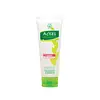What's inside
What's inside
 Key Ingredients
Key Ingredients

 Benefits
Benefits

 Concerns
Concerns

 Ingredients Side-by-side
Ingredients Side-by-side

Water
Skin ConditioningGlycerin
HumectantPalmitic Acid
EmollientGlyceryl Stearate
EmollientMyristic Acid
CleansingPotassium Hydroxide
BufferingLauric Acid
CleansingButylene Glycol
HumectantOlea Europaea Fruit Oil
MaskingLauramide DEA
Potassium Cocoyl Glycinate
Lauryl Hydroxysultaine
CleansingPotassium Chloride
Alcohol Denat.
AntimicrobialParfum
MaskingCI 77891
Cosmetic ColorantTocopheryl Acetate
AntioxidantO-Cymen-5-Ol
AntimicrobialDipotassium Glycyrrhizate
HumectantArctostaphylos Uva-Ursi Leaf Extract
Skin ConditioningMagnesium Ascorbyl Phosphate
AntioxidantLactic Acid
BufferingArbutin
AntioxidantSodium Acetylated Hyaluronate
HumectantWater, Glycerin, Palmitic Acid, Glyceryl Stearate, Myristic Acid, Potassium Hydroxide, Lauric Acid, Butylene Glycol, Olea Europaea Fruit Oil, Lauramide DEA, Potassium Cocoyl Glycinate, Lauryl Hydroxysultaine, Potassium Chloride, Alcohol Denat., Parfum, CI 77891, Tocopheryl Acetate, O-Cymen-5-Ol, Dipotassium Glycyrrhizate, Arctostaphylos Uva-Ursi Leaf Extract, Magnesium Ascorbyl Phosphate, Lactic Acid, Arbutin, Sodium Acetylated Hyaluronate
Water
Skin ConditioningSodium Cocoyl Glycinate
CleansingSodium Lauroyl Isethionate
CleansingCocamidopropyl Betaine
CleansingGlycerin
HumectantCocamide DEA
EmulsifyingAcrylates Copolymer
Sodium Methyl Cocoyl Taurate
CleansingGlycol Distearate
EmollientSodium Chloride
MaskingPhenoxyethanol
PreservativeParfum
MaskingMethylparaben
PreservativeCitric Acid
BufferingPolyquaternium-7
Sodium Polyphosphate
Disodium EDTA
Ethylhexylglycerin
Skin ConditioningSodium Erythorbate
AntioxidantCI 77288
Cosmetic ColorantSodium Benzoate
MaskingCI 77492
Cosmetic ColorantCentella Asiatica Leaf Extract
Skin ConditioningTocopheryl Acetate
AntioxidantO-Cymen-5-Ol
AntimicrobialMagnesium Ascorbyl Phosphate
AntioxidantButyl Avocadate
Skin ConditioningSalicylic Acid
MaskingAsiaticoside
AntioxidantMadecassic Acid
Skin ConditioningAsiatic Acid
Skin ConditioningAmylopectin
Dextrin
AbsorbentXanthan Gum
EmulsifyingAlcohol
AntimicrobialWater, Sodium Cocoyl Glycinate, Sodium Lauroyl Isethionate, Cocamidopropyl Betaine, Glycerin, Cocamide DEA, Acrylates Copolymer, Sodium Methyl Cocoyl Taurate, Glycol Distearate, Sodium Chloride, Phenoxyethanol, Parfum, Methylparaben, Citric Acid, Polyquaternium-7, Sodium Polyphosphate, Disodium EDTA, Ethylhexylglycerin, Sodium Erythorbate, CI 77288, Sodium Benzoate, CI 77492, Centella Asiatica Leaf Extract, Tocopheryl Acetate, O-Cymen-5-Ol, Magnesium Ascorbyl Phosphate, Butyl Avocadate, Salicylic Acid, Asiaticoside, Madecassic Acid, Asiatic Acid, Amylopectin, Dextrin, Xanthan Gum, Alcohol
Ingredients Explained
These ingredients are found in both products.
Ingredients higher up in an ingredient list are typically present in a larger amount.
Glycerin is already naturally found in your skin. It helps moisturize and protect your skin.
A study from 2016 found glycerin to be more effective as a humectant than AHAs and hyaluronic acid.
As a humectant, it helps the skin stay hydrated by pulling moisture to your skin. The low molecular weight of glycerin allows it to pull moisture into the deeper layers of your skin.
Hydrated skin improves your skin barrier; Your skin barrier helps protect against irritants and bacteria.
Glycerin has also been found to have antimicrobial and antiviral properties. Due to these properties, glycerin is often used in wound and burn treatments.
In cosmetics, glycerin is usually derived from plants such as soybean or palm. However, it can also be sourced from animals, such as tallow or animal fat.
This ingredient is organic, colorless, odorless, and non-toxic.
Glycerin is the name for this ingredient in American English. British English uses Glycerol/Glycerine.
Learn more about GlycerinMagnesium Ascorbyl Phosphate (MAP) is a form of Vitamin C and is an antioxidant. It can help to reduce redness, improve skin texture, reduce the effects of aging, reduce the visibility of dark spots, and brighten skin.
MAP is created by combining ascorbic acid with magnesium salt. While MAP more gentle on the skin than ascorbic acid, it is thought to be less easily-absorbed into the skin.
Due to MAP's stability up to a pH level of 7, it is more stable to air and sunlight exposure than ascorbic acid. The best pH range for MAP is between 5 and 6.
Like other forms of Vitamin C, MAP has been shown to help reduce hyperpigmentation and simulate collagen production.
As an antioxidant, it helps protect your skin against the signs of aging.
Learn more about Magnesium Ascorbyl PhosphateThis ingredient is more commonly known as IPMP or Isopropyl Methylphenol. It is a preservative and has antimicrobial properties.
According to the EPA, this ingredient is allowed for use in cleansers, creams, powders, bath products, toothpaste, perfume, and more.
Parfum is a catch-all term for an ingredient or more that is used to give a scent to products.
Also called "fragrance", this ingredient can be a blend of hundreds of chemicals or plant oils. This means every product with "fragrance" or "parfum" in the ingredients list is a different mixture.
For instance, Habanolide is a proprietary trade name for a specific aroma chemical. When used as a fragrance ingredient in cosmetics, most aroma chemicals fall under the broad labeling category of “FRAGRANCE” or “PARFUM” according to EU and US regulations.
The term 'parfum' or 'fragrance' is not regulated in many countries. In many cases, it is up to the brand to define this term.
For instance, many brands choose to label themselves as "fragrance-free" because they are not using synthetic fragrances. However, their products may still contain ingredients such as essential oils that are considered a fragrance by INCI standards.
One example is Calendula flower extract. Calendula is an essential oil that still imparts a scent or 'fragrance'.
Depending on the blend, the ingredients in the mixture can cause allergies and sensitivities on the skin. Some ingredients that are known EU allergens include linalool and citronellol.
Parfum can also be used to mask or cover an unpleasant scent.
The bottom line is: not all fragrances/parfum/ingredients are created equally. If you are worried about fragrances, we recommend taking a closer look at an ingredient. And of course, we always recommend speaking with a professional.
Learn more about ParfumTocopheryl Acetate is AKA Vitamin E. It is an antioxidant and protects your skin from free radicals. Free radicals damage the skin by breaking down collagen.
One study found using Tocopheryl Acetate with Vitamin C decreased the number of sunburned cells.
Tocopheryl Acetate is commonly found in both skincare and dietary supplements.
Learn more about Tocopheryl AcetateWater. It's the most common cosmetic ingredient of all. You'll usually see it at the top of ingredient lists, meaning that it makes up the largest part of the product.
So why is it so popular? Water most often acts as a solvent - this means that it helps dissolve other ingredients into the formulation.
You'll also recognize water as that liquid we all need to stay alive. If you see this, drink a glass of water. Stay hydrated!
Learn more about Water